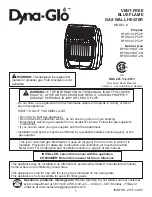
6.2.
LEAKAGE TEST
WARNING! Never perform leak test near sources of ignition.
6.2.1.
Gas connections are tested at the factory. A complete gas tightness check must be completed at the installation site prior to use.
6.2.2.
Make a solution of one part liquid detergent and one part water.
The soap solution can be applied with
spray bottle, brush or rag. Soap
bubbles will appear at the site of a leak.
6.2.3.
Test must be performed with a full cylinder.
6.2.4.
Make sure the safety control valve is in the off position. Turn the gas supply on. In the case of a leak turn the gas supply off, re-tighten
any fittings, then turn the gas supply on and re-check.
6.3.
LOCATION OF HEATER refer to fig.3
▲
DANGER
The use of this heater in enclosed areas is dangerous and is prohibited.
6.3.1.
Ensure that adequate fresh air ventilation is provided.
6.3.2.
Always maintain proper clearance from combustible materials, i.e top 100cm and sides100cm minimum.
6.3.3.
Place on level solid ground.
6.3.4.
Never operate in an explosive atmosphere for example where explosive or flammable substances are stored.
6.3.5.
Protect from strong wind. Anchor securely to the ground with screws, refer to fig.3A.
6.4.
TO TURN ON THE HEATER refer to fig.4
6.4.1.
Turn cylinder valve fully on.
6.4.2.
Press in and turn the variable control knob to PILOT position (counter clockwise 90°).
6.4.3.
Press down the variable control knob and hold in for 90 seconds. Whilst holding down the variable control knob, press the igniter
button several times until the pilot flame lights. Variable control knob can be released after the pilot flame lights.
NOTE:
- If a new gas bottle has been connected, allow at least one minute for the air in the gas pipeline to purge out through the pilot
hole.
- When lighting the pilot flame make sure the variable control knob is continuously pressed down, whilst pressing the igniter button.
- Variable control knob can be released after the pilot flame ignites.
- Pilot flame can be watched and checked from the small round window with the sliding lid, located at the bottom of the flame screen
(to the left or right side of the controller).
- If the pilot flame does not light or goes out repeat 6.4.3. above.
6.4.4.
After the pilot flame lights, turn the variable flame knob to maximum position and leave it there for 5 minutes or more before turning the
knob to the desired position.
6.5.
TO TURN OFF THE HEATER
6.5.1.
Turn the variable control knob to the pilot position.
6.5.2.
Push knob in and move knob to off position.
6.5.3.
Turn off valve on cylinder completely.
6.6.
CHECK HEATER IMMEDIATELY IF:
- heater does not reach temperature,
- burner makes a popping noise during use (a slight noise is usual when the burner is extinguished).
- smell of gas in conjunction with extreme yellow tip of burner flame.
7. STORAGE
7.1.
Always turn off the gas valve on the gas cylinder after use.
7.2.
Disconnect the valve from the cylinder.
7.3.
Check the tightness of the gas valve. Check gas valve for damage. If damage is suspected have it inspected/changed by a gas
stockist.
8
DO NOT
store a liquid gas cylinder in a cellar or in places without adequate air ventilation.
8. MAINTENANCE
8.1.
GAS HOSE
8.1.1.
Check the hose at least once a month, each time the cylinder is changed, or after a period when the heater has not been used.
8.1.2.
If it shows signs of cracking, splitting or other deterioration it must be changed for a new hose of equivalent length and quality.
8.2.
CLEANING
8.2.1.
Wipe surfaces with a soft, moist rag.
DO NOT
use combustible or corrosive cleaners.
8.2.2.
Remove debris from the burner to keep it safe for use.
8.2.3.
Cover the burner unit with the optional protective cover (Model no. DG4) when not in use.
fig.3
fig.4
Original Language Version
D
G96, DG97 Issue:1 24/12/20
fig.3A























